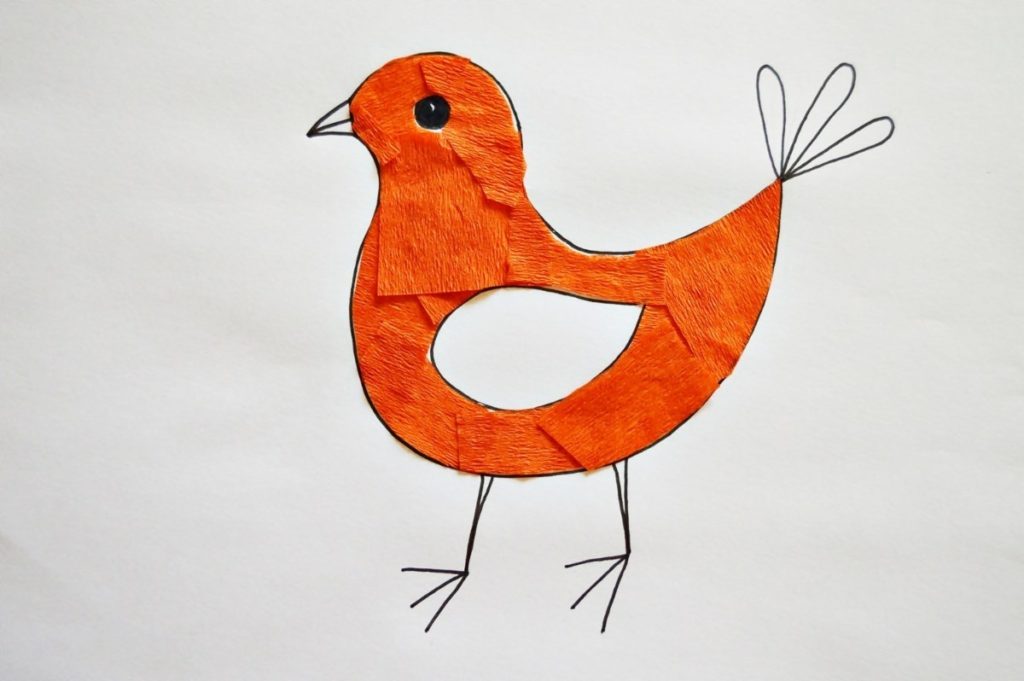Who doesn’t love the birds? And think about all the great birds in literature: Stuart Little’s Margalo, Harry Potter’s Hedwig, Mo Willems’s Pigeon. Edgar Allan Poe’s Raven. The doleful Dodo in Alice in Wonderland. And all those piratical parrots.
See below for bird stories, bird science, birds in art, bird food recipes, mathematical birds, famous birds, and the best birds in movies.
Table of Contents
BIRD STORIES
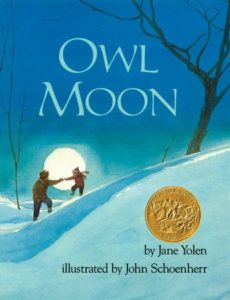 |
Jane Yolen’s Owl Moon (Philomel, 1987) is a magical picture-book story about a walk through the winter woods at night to go owling. For ages 3-8. |
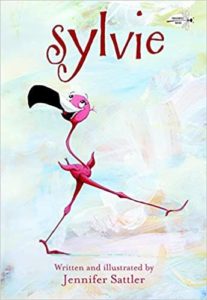 |
In Jennifer Sattler’s Sylvie (Random House, 2009), Sylvie – a little flamingo – asks her mother why flamingos are pink and discovers that it’s because of the pink shrimp that they eat. Sylvie promptly sets out to experiment, snacking on grapes (which turn her purple), chocolate (brown), a red kite (scarlet), and even a paisley bathing suit (paisley-patterned). Finally, however, she discovers that she’d prefer to be her own pink self. For ages 3-7. (Pair this one with Leo Lionni’s A Color of His Own (Dragonfly, 1997).) |
| Also see Colors. | |
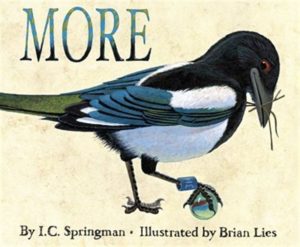 |
In I.C. Springman’s More! (Houghton Mifflin Harcourt, 2012), an acquisitive magpie learns about the perils of too much stuff with the help of some friendly mice. When the book begins, the magpie has nothing, until a mouse offers him a marble – but soon, obsessively collecting, he passes from “plenty” to “much too much.” A nicely done lesson on materialism (with a bird). For ages 4-8. |
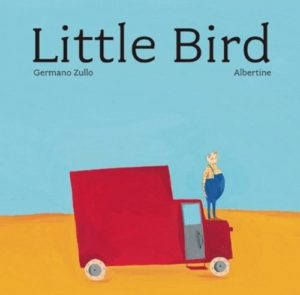 |
In Germano Zullo’s charming Little Bird, a bright red truck stops by a cliff and the driver – an egg-shaped man in overalls – gets out, opens the back door, and releases a flock of birds. Just one little blackbird is left behind, and the man does his best to encourage him to go with the flock, by flapping his arms to imitate flying. Finally (after sharing a sandwich) the bird leaves – only to return with the entire flock to carry the man up into the sky. For ages 4-8. |
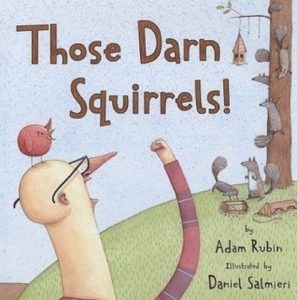 |
Adam Rubin’s hilarious and delightful Those Darn Squirrels! (Sandpiper, 2011) features the unspeakably grumpy Old Man Fookwire, who hates pies and puppies – but loves birds. He paints bird portraits and fills his yard with beautiful bird feeders, in hopes of persuading his beloved birds stay with him through the winter. The feeders promptly attract a gang of particularly persistent and innovative (they’re good with pulleys and catapults) squirrels. When the birds do fly south, leaving Old Man Fookwire alone in his house mournfully eating cottage cheese, the squirrels decide to do him a good turn in payment for all the goodies they’ve nabbed. For ages 4-8. |
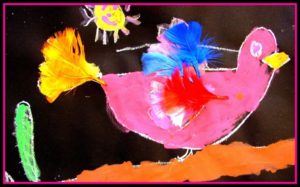 |
Inspired by Old Man Fookwire? From Deep Space Sparkle Art Lessons for Kids, see How to Draw a Bird for a great bird drawing, painting, and decorating project. Make beautiful bird portraits of your own. |
| Also see Squirrels. | |
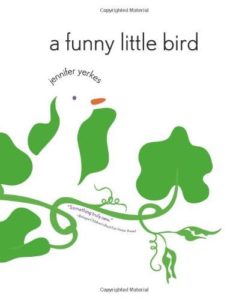 |
In Jennifer Yerkes’s A Funny Little Bird (Sourcebooks Jabberwocky, 2013), the little bird is essentially invisible – so he sets about decorating himself with flowers, leaves, and discarded feathers. The new plumage backfires, however, when it catches the attention of predators, and the little bird decides that it’s far better to stay as he is and use his camouflage talents to help his friends. For ages 4-6. |
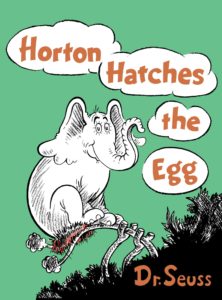 |
In Dr. Seuss’s Horton Hatches the Egg (Random House, 2004), Horton, the kind and patient elephant, determinedly cares for the egg left behind by lazy bird Maysie, who has taken off for Palm Springs. (“I said what I meant and I meant what I said/An elephant’s faithful, one hundred percent!”) And at last, when the egg hatches, Horton gets a wonderful reward. For ages 4-8. |
| For many more egg resources, see Eggs. | |
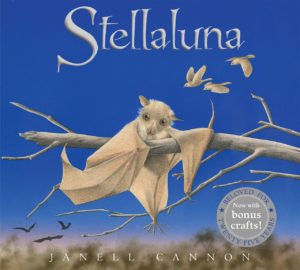 |
Janell Cannon’s Stellaluna (Houghton Mifflin Harcourt, 1993) is the story of a little fruit bat who, attacked by an owl, falls and lands in a nest of birds. Her new siblings teach her about life as a bird – and she, in turn, shows them what life is like for bats. It’s a lovely story about friendship, despite differences. (Stellaluna, at the end, is reunited with her mother and discovers that she’s supposed to eat mangoes, not bugs.) For ages 4-8. |
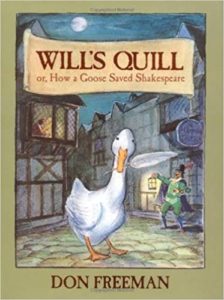 |
In Don Freeman’s Will’s Quill, or How a Goose Saved Shakespeare (Viking Juvenile Books, 2004), Willoughby, a country goose, heads for London to see the sights. There he has a hard time until befriended by playwright Will Shakespeare – and ultimately, by providing feathers for quill pens, he does Will a great service in return. For ages 5-8. |
| See more resources for all ages on Shakespeare. | |
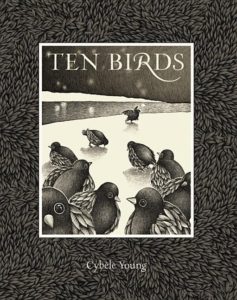 |
In Cybele Young’s Ten Birds (Kids Can Press, 2011), ten birds – with such names as Brilliant, Extraordinary, and Shows Great Promise – are trying to figure out how to cross a river. Each comes up with an imaginative solution – stilts, a water bicycle, a parachute, a kite – until it’s the turn of the tenth bird, known as Needs Improvement. Who comes up with the simplest and cleverest solution of all. For ages 5-10. |
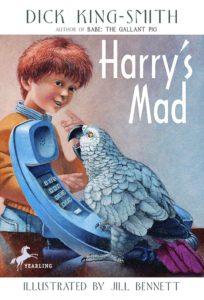 |
In Dick King-Smith’s chapter book Harry’s Mad (Yearling, 1997), Mad is a bird – a highly intelligent and creative talking parrot named Madison, left to Harry by his eccentric uncle. Trouble strikes when Mad is parrot-napped. For ages 6-10. |
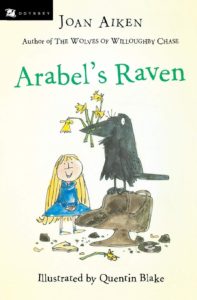 |
In Joan Aiken’s Arabel’s Raven (Houghton Mifflin Harcourt, 2007) – with illustrations by the incomparable Quentin Blake – Arabel’s father, a taxi driver, brings home an injured bird. Subsequently named Mortimer, the raven – who insists on answering the telephone by squawking “Nevermore!” – wreaks havoc. He’s a sort of avian Paddington Bear. Arabel loves him and so do I. For ages 7-10. |
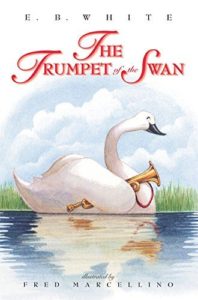 |
In E.B. White’s The Trumpet of the Swan (HarperCollins, 2001), originally published in 1970, eleven-year-old Sam discovers a family of trumpeter swans while on a camping trip – the youngest of whom, a cygnet named Louis, is mute. Louis’s father steals a brass trumpet from a music store to give his son a voice. A wonderful book for ages 8-12. |
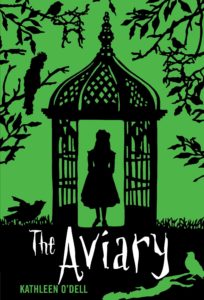 |
In Kathleen O’Dell’s The Aviary (Yearling, 2012), eleven-year-old Clara and her mother live in a crumbling mansion with old Mrs. Glendoveer. Clara, said to have a weak heart, is forbidden to run, play, or go to school – but nonetheless manages to make a friend and to solve the mystery of the Glendoveers’ past. It’s a spooky and addictive story that involves vanished children and the birds caged in the great aviary behind the house. For ages 8-12. |
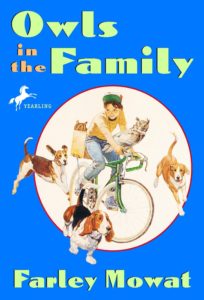 |
In Farley Mowat’s Owls in the Family, Billy – growing up on the plains of Canada – adopts two personality-laden pet owls, Wol and Weeps, who promptly turn the family and the neighborhood upside-down. For ages 8-12. |
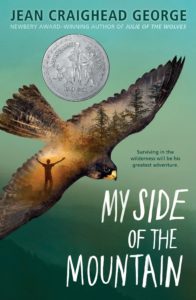 |
The main character in Jean Craighead George’s My Side of the Mountain (Puffin Books, 2004) is 12-year-old Sam Gribley who runs away from home to live on his own in a hollow tree in the Catskills. There he learns to survive, and adopts and tames a peregrine falcon chick, which he names Frightful. A wonderful read for any kid who has ever dreamed of life in the woods – and luckily there are several sequels. For ages 8-12. |
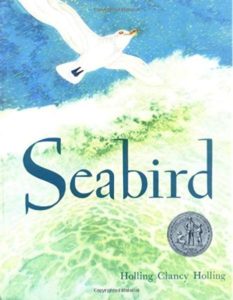 |
Holling C. Holling’s Seabird (Houghton Mifflin Harcourt, 1978) is the story of a carved ivory seagull who travels across oceans and through time with four generations of seafarers, from a Nantucket whaling ship to a clipper, a steamship, and an airplane. The carving is made by young Ezra Brown, based on the seagull he saw in a snowstorm from the crow’s-nest of the whaling ship. It’s a wonderful book, illustrated both with colorful paintings and detailed marginal drawings, diagrams, and maps. For ages 9-12. |
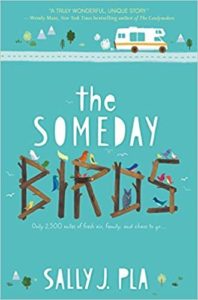 |
In Sally J. Pla’s The Someday Birds (HarperCollins, 2017), young Charlie is on a crazy cross-country journey with his siblings to visit their journalist father in the hospital, where he is being treated for a brain injury sustained in Afghanistan. Along the way, Charlie copes with his worries by trying to spot all the birds that he and his father had planned to see “someday,” with the help of the serendipitously discovered journal of a famous birder. For ages 8-12. |
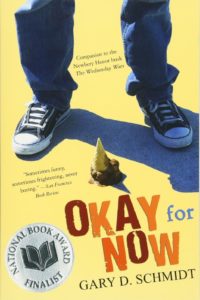 |
An abusive father, a brother who has lost his legs in Vietnam, and an original edition of Audubon’s Birds of America are all factors in the life of eighth-grader Douglas Swieteck, main character in Gary D. Schmidt’s Okay for Now (Clarion, 2011). For ages 10-14. |
